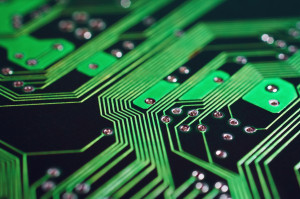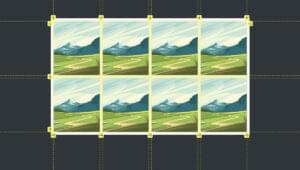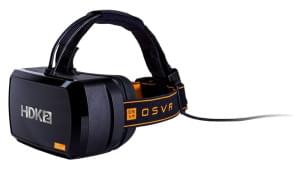Create Stunning Image Effects with CSS Backdrop-filter
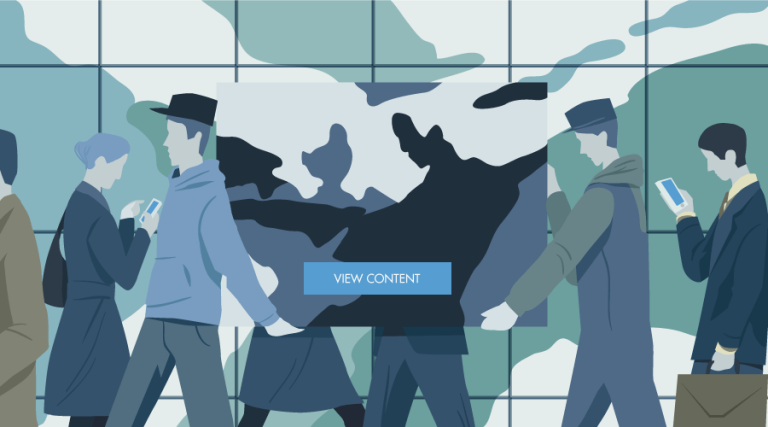
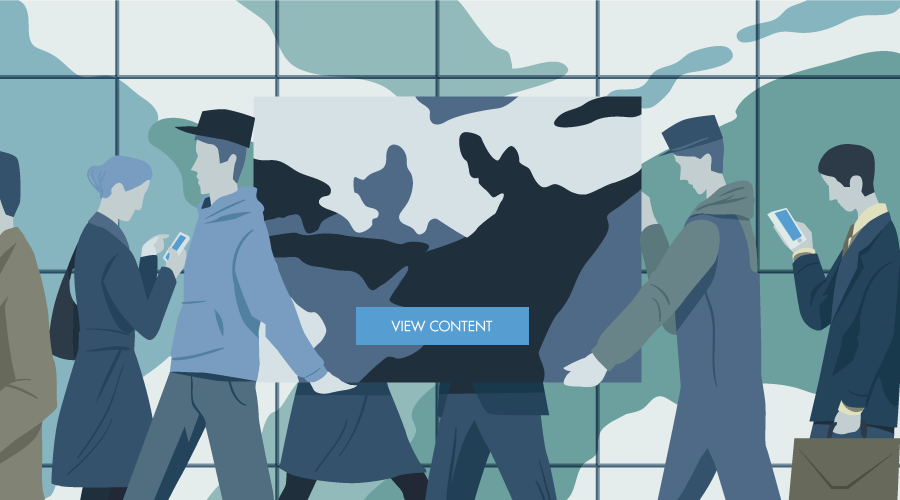
Today, we are going to learn about the CSS backdrop-filter property, which was introduced in the Filter Effects Module Level 2 specification. In particular, we will cover the backdrop-filter property’s syntax, browser support and practical applications.
All images included in this article’s demos are from Pixabay.com.
Key Takeaways
- The CSS backdrop-filter property allows the application of effects like blur and sepia to the area behind a given element, not the element itself. The effects are not applied to the element’s background but to what lies below the element, and the element’s background must be at least slightly transparent for the effects to be visible.
- The backdrop-filter property shares many features with the filter property, including the ability to apply multiple filters to the backdrop of an element. However, it does not have the same wide browser support as the filter property, with only Safari 9 supporting it without a flag.
- The backdrop-filter property can be used to create a variety of effects, such as blurring an image to warn users before showing graphic content, creating a blurry background when showing a modal to the user, or blurring out the background behind an off-canvas menu when it pops up.
- While the backdrop-filter property can recreate effects that previously required JavaScript, it is recommended to wait until there is sufficient browser support before using it in production. It’s also important to consider performance, as using this property on a large number of elements or a large area of a webpage can negatively impact performance.
Backdrop-filter Is Not the Same as Filter
You have probably already heard about CSS filters. If you need a refresher on this topic, CSS Filter Effects: Blur, Grayscale, Brightness and More in CSS! is a great read.
While the filter property helps us apply effects like blur and sepia on a given element, the backdrop-filter property will help us apply the same effects to the area behind the element. Here is a demo to illustrate the difference (make sure you use a capable browser like Chrome with the Experimental Web Platform Features flag enabled — more on browser support in the next section):
See the Pen Filter vs Backdrop Filter by SitePoint (@SitePoint) on CodePen.
In the first case, the filter was applied to the whole image, in the second case it was just applied to the part right behind our text content. I would like to make it clear that the effect is not applied to the element’s own background but to what lies below the element. You also have to keep the element’s own background at least slightly transparent otherwise visitors won’t be able to see the intended visual effects.
Syntax and Browser Support
The backdrop-filter property shares a number of features with the filter property that you are probably already familiar with. You can apply it on any element using the following syntax:
backdrop-filter: <filter-function> [<filter-function>]* | noneJust like the filter property, you can apply multiple filters to the element’s backdrop. All the values that are valid for the filter property are also valid for the backdrop-filter property. This property is also animatable.
Despite the many similarities between both properties, backdrop-filter does not enjoy the same wide browser support as the filter property. Right now, only Safari 9 supports this property without a flag, and even in this case you have to use the -webkit- prefix.
For Chrome and Opera, you can enable the “Experimental Web Platform Features” flag under ‘chrome://flags’. The property is not supported at all in Firefox and Edge. You can read more about browser support for backdrop-filter on Can I use.
Using Backdrop-filter
The backdrop-filter property needs at least two elements to work properly — a target element and another element right under our target, to which the effects will be applied. To create the backdrop effect in our demo above, we used the following markup:
<div class="backdrop">
<div class="content">
<h3>A Heading</h3>
<p>Some random text related to the heading.</p>
</div>
</div>We also used the following CSS to apply the filter on our element’s backdrop and set a background for our text content:
.backdrop {
background: url('path/to/image.jpg');
}
.content {
position: relative;
top: 30%;
background: rgba(100,150,100,0.35);
backdrop-filter: hue-rotate(180deg);
}Another interesting use for this property is to apply different filters to different parts of the image. I am not talking about applying multiple filters simultaneously to the whole image, which, by the way is also possible. I am talking about applying, let’s say, the grayscale filter on the left part of our image and the sepia filter on the right side, or divide the image into multiple parts and apply hue-rotate on all parts with different values. One way to achieve this is by setting the opacity of our target elements to zero so that they do not interfere with the image below them that we are trying to apply the filters to.
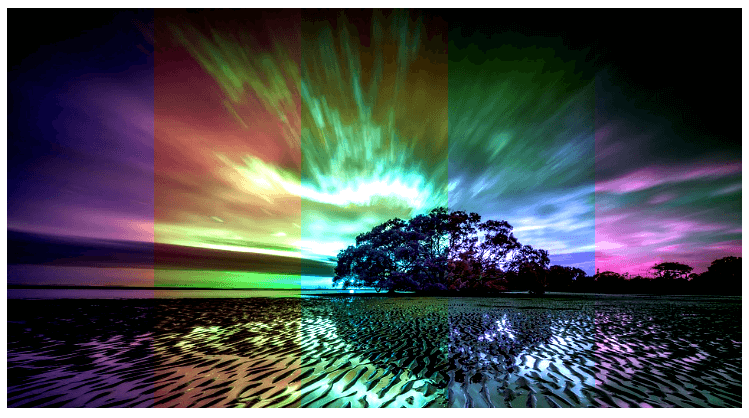
Here is the markup that you need:
<div class="backdrop">
<div class="target a">
</div>
<div class="target b">
</div>
....
</div>And this is the CSS:
.target {
position: absolute;
top: 0%;
height: 100%;
width: 20%;
opacity: 0;
}
.a {
left: 0%;
backdrop-filter: hue-rotate(30deg);
}
.b {
left: 20%;
backdrop-filter: hue-rotate(90deg);
}
/* Filters for other sections of the image */This is the final result in my case:
See the Pen Multiple Side by Side Filters by SitePoint (@SitePoint) on CodePen.
How good the image finally looks will depend on your image as well as the filters you choose to apply, but if used properly this property can create some really cool effects. You should experiment with different filters to see what you can come up with yourself.
We can also animate different properties of our target elements. For example, in the following demo there are two divs at the top of our image and I have applied a different filter to each of them.
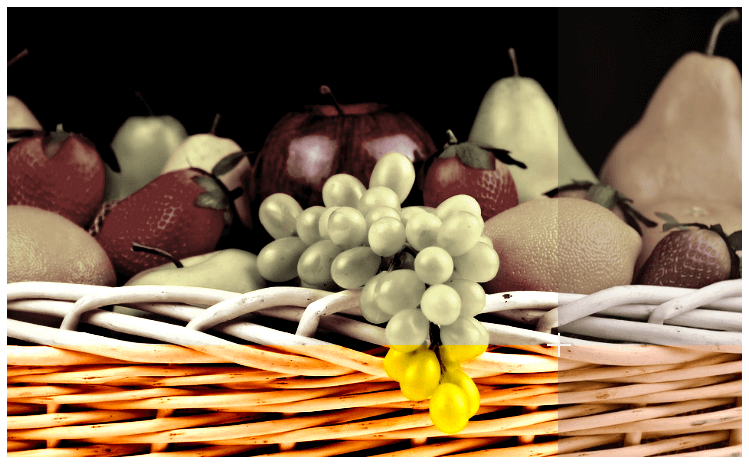
When someone hovers over the image, the width of the first div and the height of the second one change from 0% to 80% over a period of 0.5s. This divides our image into four different sections, each with its own combination of filters applied to it:
See the Pen Animating Target Elements by SitePoint (@SitePoint) on CodePen.
Other possibilities include using SVG filters and animating the filters applied to target elements.
Applications
Creating all these fancy effects using backdrop-filter is nice but the property can have a lot of practical applications too. One thing that immediately crossed my mind when I came to know about this property was how we can use it to blur an image and warn users before showing them some graphic content.

This is the markup that we need to get started:
<div class="graphic-content">
<img src="path/to/graphic/image.jpg">
<div class="warning">
<p>Click on the button below to see the image from the murder scene.</p>
<button>Show Me</button>
</div>
</div>We wrap both the image that we intend to blur and the warning text inside a div. The warning text is further wrapped inside another div which will have a width and height equal to that of the image.
And here is the CSS to create the blurring effect on the image:
.warning {
background: rgba(0,0,0,0.75);
backdrop-filter:contrast(4) blur(20px);
}You can experiment with different background colors and filters to see what suits you best. In the demo, I have also added some JavaScript to hide the warning text after the user clicks on the “Show Me” button. You should give it a try:
See the Pen Blurring Out Graphic Content by SitePoint (@SitePoint) on CodePen.
You can also use the backdrop-filter property to create a blurry background when showing a modal to the user or to blur out the background behind an off-canvas menu when it pops up. Another use for backdrop-filter is to blur the images on your webpage until they are fully loaded like they do it on Medium.
Conclusion
Using the backdrop-filter property, you will be able to recreate a lot of effects that previously required JavaScript. However, I would recommend that you wait until there is sufficient browser support before using it in production. One more thing that you should keep in mind while using backdrop-filter is performance. Using this property on a significant number of elements or on a large area of your webpage will have adverse effects on performance.
You can read more about the backdrop-filter property in the W3C draft and the MDN documentation.
Can you suggest any other interesting uses for this property? How are you planning on using it in the future? Let us know in the comments.
Frequently Asked Questions about CSS Backdrop Filter
What is the CSS backdrop-filter property and how does it work?
The CSS backdrop-filter property is a powerful tool that allows you to apply graphical effects such as blurring or color shifting to the area behind an element. This property takes the same functions as the CSS filter property, but instead of applying them to the element itself, it applies them to everything that’s behind the element, including text and images. This can create a variety of stunning visual effects and can enhance the user interface of a website or application.
How can I use the CSS backdrop-filter property to create a blur effect?
To create a blur effect using the CSS backdrop-filter property, you can use the blur() function. The blur() function takes a length value as a parameter, which specifies the amount of blur. For example, if you want to apply a 10px blur to the backdrop of an element, you can use the following code:.element {
backdrop-filter: blur(10px);}
Can I use multiple effects with the CSS backdrop-filter property?
Yes, you can use multiple effects with the CSS backdrop-filter property. You can specify multiple functions in the backdrop-filter property, separated by spaces. The effects will be applied in the order they are listed. For example, if you want to apply a blur and a grayscale effect, you can use the following code:.element {
backdrop-filter: blur(10px) grayscale(100%);}
Is the CSS backdrop-filter property supported in all browsers?
The CSS backdrop-filter property is not supported in all browsers. As of now, it is supported in Chrome, Safari, and Opera. It is not supported in Internet Explorer and has partial support in Firefox. You can check the current level of support on websites like Can I Use.
What are some common use cases for the CSS backdrop-filter property?
The CSS backdrop-filter property can be used in a variety of ways to enhance the user interface of a website or application. Some common use cases include creating a frosted glass effect, enhancing overlays or modals, creating depth and visual interest, and improving readability of text on complex backgrounds.
How can I create a frosted glass effect using the CSS backdrop-filter property?
To create a frosted glass effect, you can use the blur() function with a high value and combine it with the brightness() function to lighten the backdrop. Here’s an example:.element {
backdrop-filter: blur(10px) brightness(150%);}
Can I animate the effects applied with the CSS backdrop-filter property?
Yes, you can animate the effects applied with the CSS backdrop-filter property using CSS transitions or animations. This can create dynamic, interactive effects that respond to user interaction.
What is the difference between the CSS filter property and the CSS backdrop-filter property?
The main difference between the CSS filter property and the CSS backdrop-filter property is that the filter property applies effects to the element itself, while the backdrop-filter property applies effects to everything that’s behind the element.
Can I use the CSS backdrop-filter property with pseudo-elements?
Yes, you can use the CSS backdrop-filter property with pseudo-elements like ::before and ::after. This can be useful for creating complex visual effects without adding extra markup to your HTML.
What are some best practices for using the CSS backdrop-filter property?
Some best practices for using the CSS backdrop-filter property include testing your design in different browsers to ensure compatibility, using fallbacks for browsers that don’t support the backdrop-filter property, and using it sparingly to avoid overloading the user’s system resources.
Asha is a front-end developer and instructor who enjoys working with new and interesting JavaScript libraries. She also likes to travel and she reads a lot of books in her free time.

